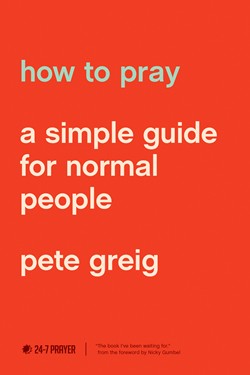You can imagine the Lord speaking your name, saying “I love you so much.” Instinctively, you reply, “Thank you, Lord.” The conversation has begun.
by Pete Greig, author of How to Pray
Pastor Mark Batterson says that “Scripture is God’s way of initiating a conversation; prayer is our response. The paradigm shift happens when you realize that the Bible wasn’t meant to be read through; the Bible was meant to be prayed through. And if you pray through it, you’ll never run out of things to talk about.”[i] How do we do this? How do we “pray through” the Bible in the way Batterson recommends? First, try to read it slowly and preferably out loud. When particular words or phrases grab your attention, linger a little, savor them like a glass of wine or a favorite piece of music. Our educational systems and even our churches haven’t taught us to read in this way—slowly and meditatively—but it’s an exceptionally simple and powerful thing to do.

As you explore these phrases, personalize and apply them to your own life. Allow your mind to go on bunny trails. Don’t get too hung up on the literal meaning—this is a subjective exercise. Try to process the text intuitively the way you might view a great work of art. Or come at it like a cryptic crossword puzzle in which the words on the page are clues hiding a meaning and a message just for you. Try to turn your thoughts, your questions, and even your distractions into prayers.
Let’s try this approach with the most famous verse in the Bible, John 3:16: “For God so loved the world that he gave his one and only Son, that whoever believes in him shall not perish but have eternal life.” Initially, you might find yourself arrested by just those first six words: “For God so loved the world.” You could repeat them a few times and feel the weight of that one little word, “so.” God so loved the world. He didn’t just love us a bit. He loved us a lot. It’s extravagant. You picture the apostle John underlining this word so in the original scroll. You can imagine the Lord speaking your name, saying “I love you so much.” Instinctively, you reply, “Thank you, Lord.” The conversation has begun.

As you continue to circle these six words, you’re struck by the fact that God loves “the world” so much. Your mind turns to your own little patch of it and your annoying neighbor. You ask God to help you be a bit more loving today. You think of your friend Johnny. “For God so loved Johnny that he gave Jesus.” You sigh involuntarily. “Johnny doesn’t want anything to do with you right now,” you say, sensing the deep sadness of it all. “For God so loved Judith, lying there right now in that hospital bed.” You hadn’t planned on praying for Judith. She just popped into your mind. Maybe the Holy Spirit is asking you to pray for her? You send her a quick text: “How are you? Praying for you.”
I could go on. But we didn’t even get past the first six words. Whenever we approach the Bible in this way, three internal shifts begin to take place:
- We discover that there are prayer prompts and conversation starters scattered on almost every page of the Bible (even if the conversation sometimes starts with “Lord, help me to understand this bit”!).
- Our prayers shift away from our personal priorities toward topics we might never otherwise have addressed. The Lord is setting his own agenda for our prayer times.
- We hear him speaking to us more clearly as we stop reading the Bible and start praying it instead.
[i] Mark Batterson, The Circle Maker (Grand Rapids, MI: Zondervan, 2012), 96.
 How to Pray: A Simple Guide for Normal People by Pete Greig
How to Pray: A Simple Guide for Normal People by Pete Greig
Pete Greig is a worldwide authority and the face of a generation when it comes to prayer. One of the founders of the 24-7 prayer movement, he has seen, experienced, and chronicled amazing works of God in the world. While you might imagine him to be puffed up, Pete Greig is entirely the opposite. He is enchanting, down-to-earth, friendly, and most of all, very normal–and yet he tells preposterous tales about prayer (and they’re true). He is basically a regular dude who loves to talk with God.
How to Pray is written to evoke a passion for prayer in everyone—the committed follower of Jesus as well as the skeptic and the scared. The enormous blessing of How to Pray is that it is accessible, full of surprising stories of answered prayer, and tremendously engaging. The basic idea is that prayer is a conversation between you and God. Pete Greig demystifies and reenchants prayer, helping you to find prayer achievable and enjoyable, and ultimately life-giving and life-changing.
How to Pray is designed to be used together with The Prayer Course (a free video curriculum associated with the Alpha course), making it useful for personal and group or church-wide reading.




